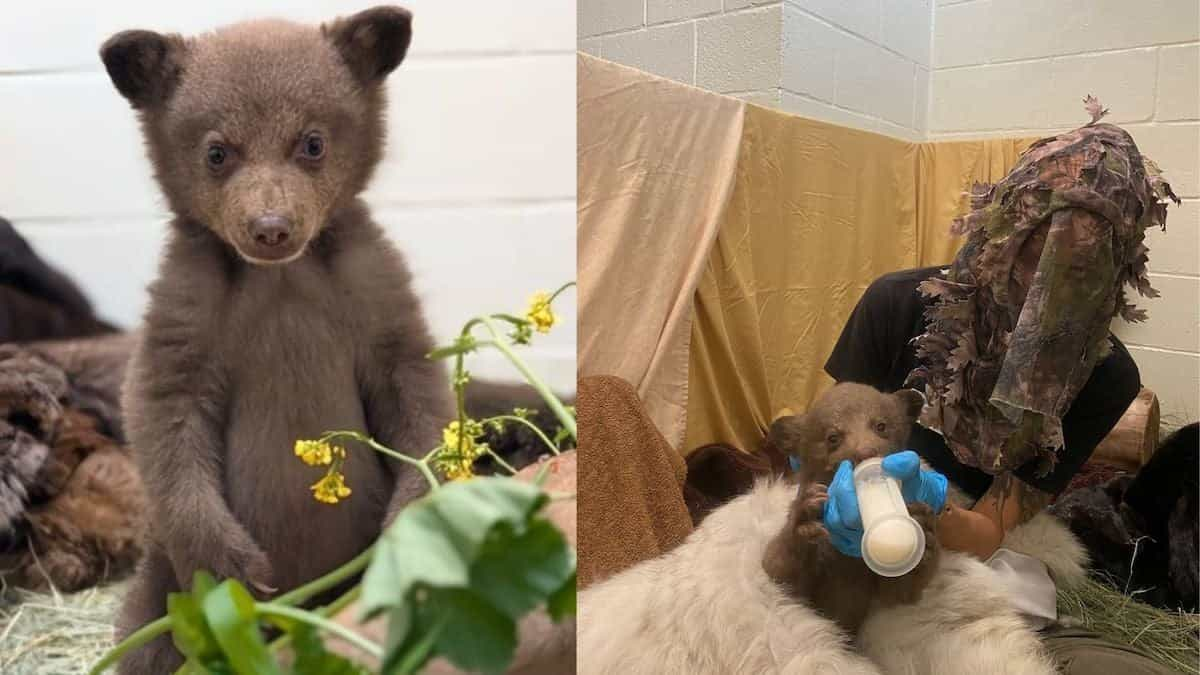Show table of content Hide table of content
In a remarkable tale of conservation and innovative care, a black bear cub abandoned at just two months old has found sanctuary with caretakers who go to extraordinary lengths to ensure his successful return to the wild. The tiny orphan, discovered in California’s Los Padres Forest, now receives specialized attention from humans wearing bear costumes to minimize human imprinting during his rehabilitation.
A heartbreaking discovery in the California wilderness
On April 12, 2025, biologists from the California Department of Fish and Wildlife made a distressing discovery in Los Padres Forest. A tiny black bear cub, estimated to be only two months old, was found alone, malnourished, and ill. Despite thorough searches, no mother bear was located in the vicinity, indicating the cub had likely been abandoned with no hope of maternal care, creating an emergency situation for wildlife officials.
The orphaned cub was immediately transported to the Ramona Wildlife Center, operated by the San Diego Humane Society. Upon arrival, wildlife specialists determined he had likely gone several days without proper nutrition, resulting in a precarious health condition that required immediate intervention.
News This TikToker buys a used van and realizes it has a hidden surveillance device.
The rescue marked a significant milestone for the center as this represented the youngest black bear ever admitted to their care. Initial days proved challenging as the cub experienced fluctuating health, similar to cases where animals spend extended periods without proper care. However, with dedicated medical attention and specialized feeding regimens, the little bear began showing promising signs of recovery.
“His condition was touch-and-go initially,” explained one wildlife specialist. “But now he’s actively engaged with his environment, consuming proper nutrition, and steadily gaining weight – all crucial indicators for his eventual release back into the wild.”
Innovative rehabilitation techniques with bear costumes
What truly sets this rehabilitation program apart is the extraordinary measures taken to prevent human imprinting. Unlike conventional animal rescue operations, the Ramona Wildlife Center has implemented a fascinating approach – caregivers don complete bear costumes during every interaction with the orphaned cub.
The specially designed costumes include realistic bear masks that completely obscure human features. Additionally, during feeding sessions, caregivers wear leafy hoods that further disguise their human presence. This meticulous approach aims to maintain the cub’s natural wariness of humans, a critical survival trait once he returns to the forest.
This method stands in stark contrast to rehabilitation techniques used in environments where traditional approaches are strictly followed, but wildlife experts believe this innovative strategy gives orphaned bears the best chance at successful reintegration.
The daily regimen includes four structured learning and feeding sessions specifically designed to mimic maternal bear behaviors. These carefully choreographed interactions help instill natural instincts and behaviors the cub would typically learn from his mother. Initially, the rehabilitation plan even included nighttime feedings to stabilize his condition – a level of care reminiscent of what mother bears provide their cubs in the wild.
Scientific foundations for successful wild reintegration
The rehabilitation approach isn’t merely intuitive – it’s grounded in scientific research. A comprehensive study published in the Journal of Wildlife Management provides encouraging evidence that orphaned black bears who undergo specialized rehabilitation can achieve survival rates equal to or even surpassing those raised by their biological mothers.
This research has informed the center’s rehabilitation protocol, which focuses on minimizing human contact while maximizing natural learning opportunities. The goal is to prepare the cub for release when he reaches approximately one year of age – the typical time when young bears begin establishing independence from their mothers.
News Bat wings after 50? Here’s the most effective exercise, according to a coach.
Wildlife experts recognize that animal rehabilitation comes with significant challenges, not unlike situations where animal welfare concerns prompt public advocacy. However, the specialized protocols developed for orphaned bears have demonstrated remarkable success.
The center’s work represents a fascinating intersection of wildlife conservation, behavioral science, and innovative thinking. While the costumed approach might seem unusual to outsiders, it addresses a fundamental challenge in wildlife rehabilitation – preparing captive animals for successful independent living in their natural habitats.
Wildlife protection and the future for orphaned bears
The plight of orphaned wildlife highlights broader conservation concerns affecting bear populations throughout California. While encountering wild animals can sometimes lead to unexpected and frightening encounters, maintaining healthy ecosystems requires dedicated wildlife management approaches.
Through their work with this orphaned cub, the San Diego Humane Society continues a tradition of wildlife stewardship that balances human interests with animal welfare. Their techniques represent evolution in conservation practice, moving beyond simple rescue to comprehensive rehabilitation that addresses psychological and behavioral needs.
The orphaned bear’s journey from abandoned cub to potential forest dweller illustrates both the fragility and resilience of wildlife. While the circumstances that led to his abandonment remain unknown, his future now holds promise thanks to dedicated human intervention designed, ironically, to minimize human influence.
Unlike situations where human-animal interactions lead to tragedy, this rehabilitation story demonstrates how thoughtful human involvement can positively impact wildlife conservation. The costumed caretakers exemplify a growing understanding that successful wildlife rehabilitation requires creating conditions that mirror natural upbringing as closely as possible.
This innovative approach to wildlife care joins other creative solutions that address modern challenges, such as technological adaptations that encourage nature appreciation. Just as archaeologists carefully preserve our connection to the past through discoveries like ancient Egyptian artifacts, wildlife rehabilitators work to ensure future generations will experience the natural world with all its diversity intact.
For now, the little orphaned bear continues growing stronger daily under the watchful eyes of his disguised human guardians, unaware that the strange-looking “bears” caring for him are actually preparing him for a successful return to the wilderness – where he truly belongs.


